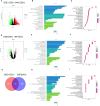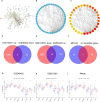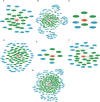Key genes involved in nonalcoholic steatohepatitis improvement after bariatric surgery
- PMID: 38469144
- PMCID: PMC10925704
- DOI: 10.3389/fendo.2024.1338889
Key genes involved in nonalcoholic steatohepatitis improvement after bariatric surgery
Abstract
Background: Nonalcoholic steatohepatitis (NASH) is the advanced stage of nonalcoholic fatty liver disease (NAFLD), one of the most prevalent chronic liver diseases. The effectiveness of bariatric surgery in treating NASH and preventing or even reversing liver fibrosis has been demonstrated in numerous clinical studies, but the underlying mechanisms and crucial variables remain unknown.
Methods: Using the GSE135251 dataset, we examined the gene expression levels of NASH and healthy livers. Then, the differentially expressed genes (DEGs) of patients with NASH, at baseline and one year after bariatric surgery, were identified in GSE83452. We overlapped the hub genes performed by protein-protein interaction (PPI) networks and DEGs with different expression trends in both datasets to obtain key genes. Genomic enrichment analysis (GSEA) and genomic variation analysis (GSVA) were performed to search for signaling pathways of key genes. Meanwhile, key molecules that regulate the key genes are found through the construction of the ceRNA network. NASH mice were induced by a high-fat diet (HFD) and underwent sleeve gastrectomy (SG). We then cross-linked the DEGs in clinical and animal samples using quantitative polymerase chain reaction (qPCR) and validated the key genes.
Results: Seven key genes (FASN, SCD, CD68, HMGCS1, SQLE, CXCL10, IGF1) with different expression trends in GSE135251 and GSE83452 were obtained with the top 30 hub genes selected by PPI. The expression of seven key genes in mice after SG was validated by qPCR. Combined with the qPCR results from NASH mice, the four genes FASN, SCD, HMGCS1, and CXCL10 are consistent with the biological analysis. The GSEA results showed that the 'cholesterol homeostasis' pathway was enriched in the FASN, SCD, HMGCS1, and SQLE high-expression groups. The high-expression groups of CD68 and CXCL10 were extremely enriched in inflammation-related pathways. The construction of the ceRNA network obtained microRNAs and ceRNAs that can regulate seven key genes expression.
Conclusion: In summary, this study contributes to our understanding of the mechanisms by which bariatric surgery improves NASH, and to the development of potential biomarkers for the treatment of NASH.
Keywords: bariatric surgery; competitive endogenous RNA; gene expression omnibus datasets; nonalcoholic fatty liver disease; nonalcoholic steatohepatitis; sleeve gastrectomy.
Copyright © 2024 Chen, Deng, Sun, Bai, Wang and Yang.
Conflict of interest statement
The authors declare that the research was conducted in the absence of any commercial or financial relationships that could be construed as a potential conflict of interest.
Figures









Similar articles
-
Integrated Analysis of Key Genes and Pathways Involved in Nonalcoholic Steatohepatitis Improvement After Roux-en-Y Gastric Bypass Surgery.Front Endocrinol (Lausanne). 2021 Feb 2;11:611213. doi: 10.3389/fendo.2020.611213. eCollection 2020. Front Endocrinol (Lausanne). 2021. PMID: 33603714 Free PMC article.
-
The role of differentially expressed genes and immune cell infiltration in the progression of nonalcoholic steatohepatitis (NASH) to hepatocellular carcinoma (HCC): a new exploration based on bioinformatics analysis.Nucleosides Nucleotides Nucleic Acids. 2024;43(12):1415-1430. doi: 10.1080/15257770.2024.2310044. Epub 2024 Feb 6. Nucleosides Nucleotides Nucleic Acids. 2024. PMID: 38319987
-
Bioinformatics analysis reveals novel core genes associated with nonalcoholic fatty liver disease and nonalcoholic steatohepatitis.Gene. 2020 Jun 5;742:144549. doi: 10.1016/j.gene.2020.144549. Epub 2020 Mar 14. Gene. 2020. PMID: 32184169
-
The role of bariatric surgery in the management of nonalcoholic steatohepatitis.Curr Opin Gastroenterol. 2021 May 1;37(3):208-215. doi: 10.1097/MOG.0000000000000721. Curr Opin Gastroenterol. 2021. PMID: 33769376 Review.
-
The Effects of Metabolic Surgery on Fatty Liver Disease and Nonalcoholic Steatohepatitis.Surg Clin North Am. 2016 Aug;96(4):703-15. doi: 10.1016/j.suc.2016.03.008. Surg Clin North Am. 2016. PMID: 27473796 Review.
Cited by
-
Identification of diagnostic hub genes related to energy metabolism in idiopathic pulmonary fibrosis.Front Mol Biosci. 2025 Jun 26;12:1596364. doi: 10.3389/fmolb.2025.1596364. eCollection 2025. Front Mol Biosci. 2025. PMID: 40642530 Free PMC article.
References
-
- Chalasani N, Younossi Z, Lavine JE, Charlton M, Cusi K, Rinella M, et al. . The diagnosis and management of nonalcoholic fatty liver disease: Practice guidance from the American Association for the Study of Liver Diseases. Hepatol (Baltimore Md) (2018) 67(1):328–57. doi: 10.1002/hep.29367 - DOI - PubMed
MeSH terms
Substances
LinkOut - more resources
Full Text Sources
Medical
Miscellaneous

